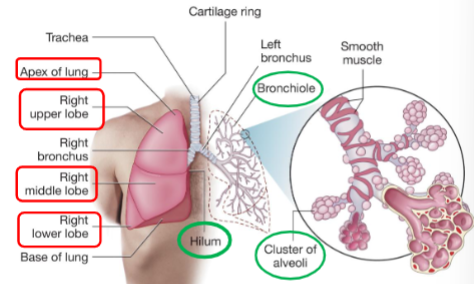Medical Terminology Unit 2 Part 1
1/13
There's no tags or description
Looks like no tags are added yet.
Name | Mastery | Learn | Test | Matching | Spaced |
|---|
No study sessions yet.
14 Terms
Pulmonology
Is the medical specialty that studies the anatomy and physiology of the respiratory system.
Pulmonologists use diagnostic tests, medical and surgical procedures, and drugs to treat respiratory diseases.
pulmon/o-: means lung
-logy: means study of
Nasal Cavity
The nose is the first part of the upper respiratory tract
It contains the nasal cavity, which is divided by the septum
nas/o = nose
-al = pertaining to
Three turbinates in the nasal cavity slow the flow of air so it can be warmed and moistened.
Nasal cavity and turbinates are lined with mucosa.
The mucous membrane humidifies air and produces mucus.
This is especially important in cold or dry areas.
Mucus and hair in the nose trap particles and prevent them from reaching the lungs.
Pharynx
The posterior part of the nasal cavity merges with the pharynx
The pharynx is a common passage for inhaled air, exhaled air, and food.
The pharynx is composed of:
- Nasopharynx
-Oropharynx
- Laryngopharynx
Larynx
The larynx (voice box) is the first part of the lower respiratory tract.
The larynx remains open during speech and respiration to allow air into the trachea.
During swallowing, the larynx pulls up to the epiglottis, forcing food into the esophagus.
Trachea
Below the vocal cords, the larynx merges into the trachea.
The trachea aka windpipe, is a passageway for inhaled and exhaled air.
It has a column of C-shaped cartilage.
-The anterior side is rigid due to the cartilage to prevent collapse.
- The posterior side has no cartilage and is soft.
The Bronchi
The trachea divides into right and left bronchi (plural of bronchus).
Bronchi are supported by rings of cartilage, similar to the trachea.
The primary (right and left) bronchi enter the lungs, where they divide into smaller bronchioles.
Bronchioles
Bronchioles are the smallest bronchi with a diameter of 1 millimeter or less.
Their walls contain smooth muscle and no cartilage.
The smooth muscle can contract or relax, to narrow or widen the bronchial lumen.
Anatomy of the Lungs
The lungs are spongy, air-filled structures.
The right lung contains three lobes (divisions) and the left lung contains two.
-Right upper lobe (RUL)
-Right middle lobe (RML)
-Right lower lobe (RLL)
-Left upper lobe (LUL)
-Left lower lobe (LLL)
The top of the lung is the apex.
The base rests on the diaphragm

Alveoli
Inside the lung, the bronchus branches into bronchioles that end in alveoli.
An alveolus is a hollow sphere of cells.
-Alveoli exchange oxygen and carbon dioxide with nearby capillaries.
-They secrete surfactant that keeps their walls from collapsing.
-The alveoli form the pulmonary parenchyma.
Thorax
The thorax is the bony area between the neck and the diaphragm.
-The rib cage (sternum, ribs, and spine) protects the lungs and thoracic cavity.
-The lungs fill most of the thoracic cavity.
-The mediastinum lies between the lungs and contains the trachea, heart, and esophagus.
-The diaphragm makes up the inferior border of the thoracic cavity.
Pleural cavity
Within the thoracic cavity, each lung lies in a pleural cavity.
This space is surrounded by a double-layered serous membrane called pleura.
The pleura secretes pleural fluid that allows the layers to smoothly slide past each other.
Respiration
A two-way path: Inhalation/inspiration and Exhalation/expiration
Eupnea
Having a normal rate and depth of respiration is Eupnea